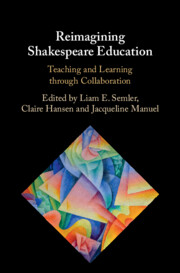Book contents
- Reimagining Shakespeare Education
- Reimagining Shakespeare Education
- Copyright page
- Dedication
- Contents
- Figures
- Tables
- Notes on Contributors
- Acknowledgements
- Introduction
- Part I Reimagining Shakespeare with/in Schools
- Introduction
- Chapter 1 Shakespeare Schools Foundation
- Chapter 2 Shakespeare and Citizenship in France
- Chapter 3 Bell Shakespeare
- Chapter 4 The Better Strangers/Shakespeare Reloaded Project
- Part II Reimagining Shakespeare with/in Universities
- Part III Public Reimaginings
- Part IV Digital Reimaginings
- Part V Reimagining Performance
- Afterword
- Index
- References
Chapter 1 - Shakespeare Schools Foundation
The Classroom as Theatre
from Part I - Reimagining Shakespeare with/in Schools
Published online by Cambridge University Press: 02 February 2023
- Reimagining Shakespeare Education
- Reimagining Shakespeare Education
- Copyright page
- Dedication
- Contents
- Figures
- Tables
- Notes on Contributors
- Acknowledgements
- Introduction
- Part I Reimagining Shakespeare with/in Schools
- Introduction
- Chapter 1 Shakespeare Schools Foundation
- Chapter 2 Shakespeare and Citizenship in France
- Chapter 3 Bell Shakespeare
- Chapter 4 The Better Strangers/Shakespeare Reloaded Project
- Part II Reimagining Shakespeare with/in Universities
- Part III Public Reimaginings
- Part IV Digital Reimaginings
- Part V Reimagining Performance
- Afterword
- Index
- References
Summary
An examination of the work of Shakespeare Schools Foundation (SSF): a UK-based cultural and education charity that introduces the work of Shakespeare to primary- and secondary-aged pupils in a ‘real-world’ active context.
The chapter looks at how SSF encourages engagement with Shakespeare’s text in collaborative teacher/practitioner/pupil partnerships, with a focus on inclusivity and rehearsal room techniques. The focus is on SSF’s flagship programme, the Shakespeare Schools Festival, which engages primary, secondary and SEN schools, and also on other residential partnerships with SEN settings.
Case studies explore how participants’ collaborative abilities and confidence increase, and highlight participation among pupils from diverse settings and disadvantaged backgrounds.
The chapter will consider how SSF’s active approach to Shakespeare contrasts with traditional instruction in the English classroom, and include the challenges faced by SSF in providing its programmes in the current UK education climate.
- Type
- Chapter
- Information
- Reimagining Shakespeare EducationTeaching and Learning through Collaboration, pp. 27 - 40Publisher: Cambridge University PressPrint publication year: 2023

